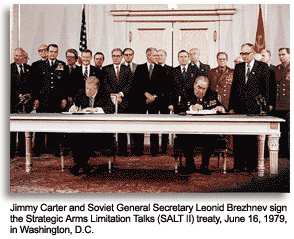On January 20, 1969, the day of Richard M. Nixon's first inauguration, the Soviet government offered to hold negotiations on the issues of nuclear arms control. Nixon immediately accepted and the Strategic Arms Limitation Talks, commonly known as SALT, were arranged. They took place in two phases: SALT I ran from 1969 to 1972 and resulted in the Anti-Ballistic Missile Treaty and the Interim Agreement Between The United States of America and The Union of Soviet Socialist Republics on Certain Measures With Respect to the Limitation of Strategic Offensive Arms. SALT II, begun in late 1972, produced a treaty that was never ratified by the U.S. Senate. In 1982, President Ronald Reagan abandoned SALT and undertook the Strategic Arms Reduction Treaty talks, commonly known as the START talks, instead.
As the third decade of the atomic age began, the continued development of the technology of nuclear weapons and delivery systems led the United States and the Soviet Union to realize the futility of an unlimited arms race in those devices. In 1968, President Lyndon B. Johnson announced that Soviet Premier Alexei Nikolayevich Kosygin had agreed to meetings on the issue, but those talks never came about.
When the Soviet Union reopened the matter in 1969, President Richard Nixon seized the opportunity, and the first meeting was held in Helsinki in November. With the help of Secretary of State Henry Kissinger, the United States negotiated the ABM Treaty and an interim agreement that essentially froze nuclear arsenals at their existing levels. Nixon and Soviet General Secretary Leonid Brezhnev signed the ABM Treaty and the interim agreement on May 26, 1972, at a summit meeting in Moscow.
 The interim agreement, commonly called the SALT I Treaty, froze the total number of Inter-Continental Ballistic Missiles, but allowed the replacement of old missiles with new ones. In the interests of achieving an actual reduction and preventing qualitative advances in destructive technology, the two nations began SALT II talks in November of the same year in Geneva. In a meeting in Vladivostok in November 1974, President Gerald Ford and Brezhnev agreed to a basic framework for a SALT II Treaty. However, international political considerations prevented the treaty from being completed until 1979. President Jimmy Carter sent the SALT II Treaty to the U.S. Senate for its advice and consent on June 22, 1979. Objections arose and the treaty had not been ratified when the Soviets invaded Afghanistan, which chilled U.S. and Soviet relations. On January 3, 1980, Carter asked that the Senate delay further consideration of the treaty. The treaty was never ratified by the Senate, but was formally honored by the U.S. and the Soviet Union. In May 1982, President Ronald Reagan declared that the United States would not violate the provisions of the treaty if the Soviets agreed to do the same. The Soviets did agree, although Reagan declared in 1984 and 1985 that the Soviet Union had violated that pledge.
A new round of talks, called the Strategic Arms Reduction Treaty, or START, replaced SALT beginning in 1983. The agreement would put a cap of 1,600 strategic nuclear delivery vehicles and 6,000 "accountable" warheads for each country, while enabling them to continue modernizing their weaponry.
The interim agreement, commonly called the SALT I Treaty, froze the total number of Inter-Continental Ballistic Missiles, but allowed the replacement of old missiles with new ones. In the interests of achieving an actual reduction and preventing qualitative advances in destructive technology, the two nations began SALT II talks in November of the same year in Geneva. In a meeting in Vladivostok in November 1974, President Gerald Ford and Brezhnev agreed to a basic framework for a SALT II Treaty. However, international political considerations prevented the treaty from being completed until 1979. President Jimmy Carter sent the SALT II Treaty to the U.S. Senate for its advice and consent on June 22, 1979. Objections arose and the treaty had not been ratified when the Soviets invaded Afghanistan, which chilled U.S. and Soviet relations. On January 3, 1980, Carter asked that the Senate delay further consideration of the treaty. The treaty was never ratified by the Senate, but was formally honored by the U.S. and the Soviet Union. In May 1982, President Ronald Reagan declared that the United States would not violate the provisions of the treaty if the Soviets agreed to do the same. The Soviets did agree, although Reagan declared in 1984 and 1985 that the Soviet Union had violated that pledge.
A new round of talks, called the Strategic Arms Reduction Treaty, or START, replaced SALT beginning in 1983. The agreement would put a cap of 1,600 strategic nuclear delivery vehicles and 6,000 "accountable" warheads for each country, while enabling them to continue modernizing their weaponry.